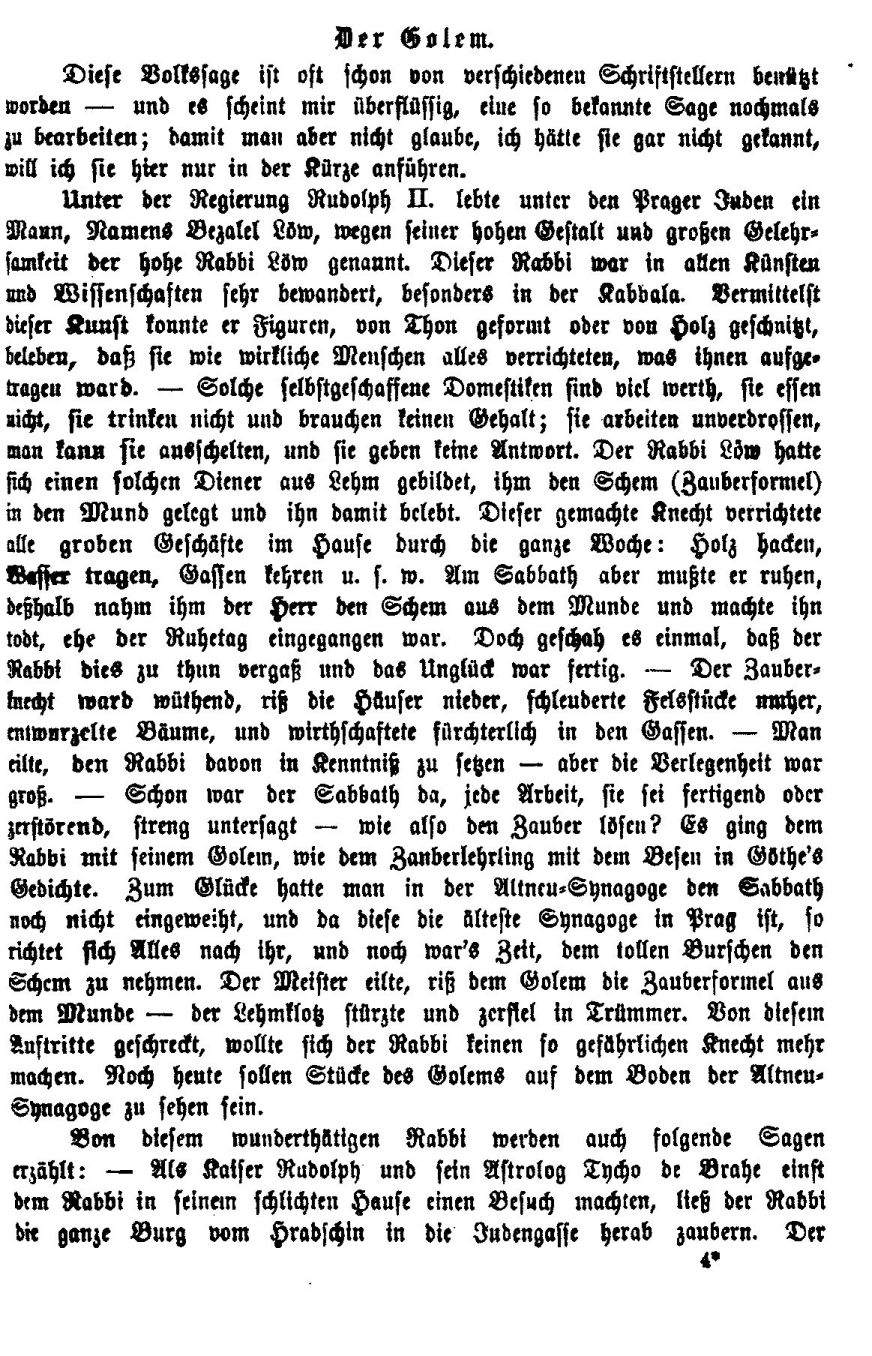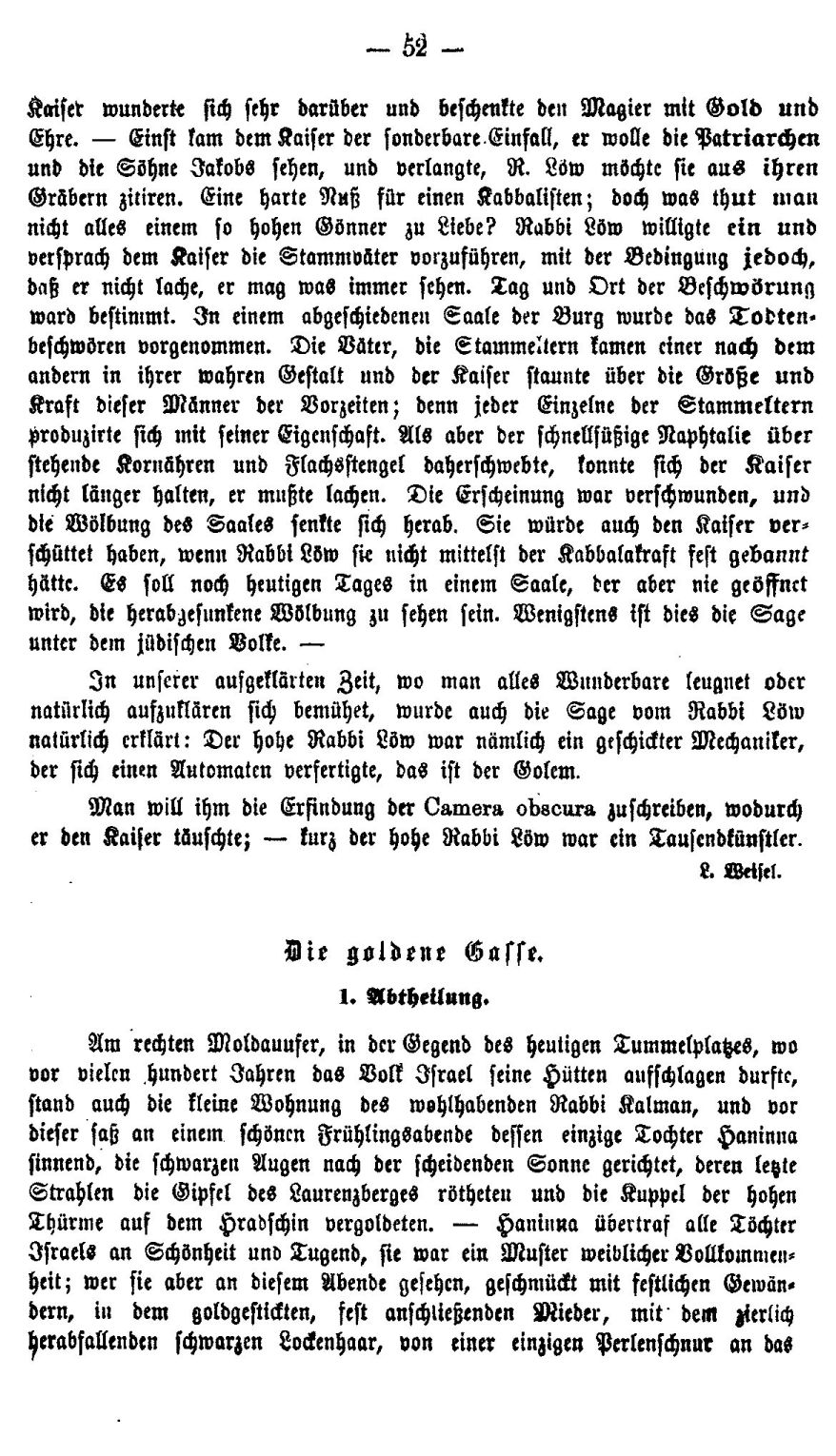


SOURCE: Weisel, Leopold. “Der Golem” (1847), in Sippurim, eine sammlung jüdischer volkssagen, erzählungen, mythen, chroniken, denkwürdigkeiten und biographieen berühmter Juden aller jahrhunderte, insbesondere des mittelalters, by Wolf Pascheles (J. B. Brandeis, 1883; orig. Prague, c. 1854), pp. 51-52.
The following is apparently a translation of the second paragraph of “Der Golem,” found in Dekel and Gantt (see below), p. 245.
In the reign of Rudolph II among the Prague Jews lived a man named Bezalel Loew, known, because of his tall stature and great learning, as high Rabbi Loew. This rabbi was highly skilled in all the arts and sciences, especially in the Kabbalah. By means of this art he was able to bring to life figures, formed of clay or carved from wood, that, like real men, did what was assigned to them. Such self-made servants are worth much: they do not eat, they do not drink and do not need wages; they work tirelessly, you can scold them and they give no answer. The Rabbi Loew had formed such a servant out of clay, laid the Shem (magic formula) in its mouth, and brought him to life with it. This constructed servant performed all the menial duties in the house throughout the week: chopping wood, carrying water, sweeping the streets, etc. But on the Sabbath he had to rest, therefore, the master took the Shem from his mouth and made him dead before the rest day arrived. But once it happened that the rabbi forgot to do this and misfortune followed. The magic servant became enraged, tore down the houses, threw rocks around, uprooted trees, and thrashed about horribly in the streets. People rushed to let the rabbi know about this, but the difficulty was great; it was already the Sabbath, and any work, whether creating or destroying, is strictly prohibited, so how to undo the magic? To the rabbi, his Golem was like the broom to the sorcerer’s apprentice in Goethe’s poem. Fortunately no one had yet inaugurated the Sabbath in the Altneu-Synagogue, and since this is the oldest synagogue in Prague, everything depends on it, and there was still time to take the Shem from the wild fellow. The master ran, tore the magic formula from the mouth of the Golem—the clay lump fell and crumbled to pieces. Terrified by this scene, the rabbi no longer wanted to make such a dangerous servant. Even today, pieces of the Golem can be seen in the attic of the Altneu-Synagogue.
Gelbin (GHI lecture, 20 May 2021) claims that Weisel was the first to link the golem and the automaton. Neubauer (see below) quotes this passage from Weisel (p. 305):
In our enlightened age, in which people deny all wonders or try to explain them naturally, the legend of Rabbi Löw has also been explained naturally. For the High Rabbi was a skilled technician, who prepared an automaton, the golem, for himself. People want to ascribe him the invention of the camera obscura, whereby he deceived the Emperor. In sum, the High Rabbi was a conjurer. (52)
Supplementary bibliography & links:
Ambros, Veronika. “How Did the Golems (and Robots) Enter Stage and Screen and Leave Prague?”, in History of the Literary Cultures of East-Central Europe: Junctures and Disjunctures in the 19th and 20th Centuries. Vol. IV: Types and Stereotypes, edited by Marcel Cornis-Pope and John Neubauer (Amsterdam; Philadelphia: John Benjamins Publishing Company, 2010), pp. 308-320.
Barzilai, Maya. Golem: Modern Wars and Their Monsters. New York: New York University Press, 2016.
Bertman, Stephen. “The Role of the Golem in the Making of Frankenstein,” The Keats-Shelley Review, Vol. 29, No. 1, April 2015, pp. 42-50.
Borges, Jorge Luis. “The Golem” (El Golem, 1964, in El otro, el mismo). Several translations online, including by:
Juan Ribó Chalmeta & Irina Urumova, with original
James Honzik
Alan S. Trueblood
Frank Thomas Smith
Bush, Lawrence. “December 23: H. Leyvik and the Golem,” Jewish Currents, December 23, 2013.
Dekel, Edan; Gurley, David Gantt. “How the Golem Came to Prague,” The Jewish Quarterly Review, Vol. 103, No. 2, Spring 2013, pp. 241-258. Weisel: pp. 244-247, & influence, passim.
Gelbin, Cathy S. The Golem Returns: From German Romantic Literature to Global Jewish Culture, 1808-2008 (Ann Arbor: The University of Michigan Press, 2011), pp. 51-54. Introduction (full text).
Goldberg, Ken. Adam, Golem, Robot. Based on a talk presented by Ken Goldberg, 1993, with a follow-up conversation between Ken Goldberg and Ovid Jacob, 1995.
“Golem,” by Gershom Scholem, Moshe Ide, in Encyclopaedia Judaica, Second Edition, Volume 7; Fred Skolnik, editor-in-chief; Michael Berenbaum, executive editor (Detroit, MI: Macmillan Reference USA in association with the Keter Publishing House, 2007), pp. 735-738.
Golem: From Mysticism to Minecraft, Jüdische Museum Berlin / Jewish Museum Berlin.
Golem - Wikipedia, the free encyclopedia.
The Golem (Leivick) - Wikipedia, the free encyclopedia.
The Golem, edited and translated by Joachim Neugroschel. New York: W. W. Norton & Company, 2006.
Introduction / Yudl Rosenberg ix
The Golem or The Miraculous Deeds of Rabbi Leyb / S. Bastomski 1
Yiddish Folktales and Legends of Old Prague (Selections) / 77
The Golem / Dovid Frishman 87
The Golem / H. Leivick 111
Idel, Moshe. Golem: Jewish Magical and Mystical Traditions on the Artificial Anthropoid. Albany, NY: State University Press, 1990.
Kieval, Hillel J. Golem Legend, YIVO Encyclopedia of Jews in Eastern Europe, 2010.
Kieval, Hillel J.; Polakovič, Daniel. Weisel, Leopold, YIVO Encyclopedia of Jews in Eastern Europe, 2010.
Mansbach, Adam. The Golem of Brooklyn: a Novel. New York: One World, 2023.
The Legend of the Golem -- Author Talk with Adam Mansbach, PBS Books, 2 November 2023 (YouTube, 50:31 min.)
Neubauer, John. “How Did the Golem Get to Prague?”, in History of the Literary Cultures of East-Central Europe: Junctures and Disjunctures in the 19th and 20th Centuries. Vol. IV: Types and Stereotypes, edited by Marcel Cornis-Pope and John Neubauer (Amsterdam; Philadelphia: John Benjamins Publishing Company, 2010), pp. 296-307.
Rubenstein, Howard S. The Golem,Man of Earth: a Play in Two Acts; based on historical events, a medieval Jewish legend, kabbalah, and the Yiddish dramatic poem by H. Leivick. San Diego: Granite Hills Press, 2007.
Scholem, Gershom. “The Golem of Prague & The Golem of Rehovoth” (June 17, 1965), Commentary, January 1966.
Scholem, Gershom. On the Kabbalah and its Symbolism, translated by Ralph Manheim. New York: Schocken Books, 1965. See Chapter 5: The Idea of the Golem, pp. 158-204.
Special Issue on The Golem—Rabbi Loew and His Legacy: The Golem in Literature and Film, Journal of the Fantastic in the Arts, vol. 7, no. 2/3 (26/27), 1995.
Introduction: "Bereshit bara Elohim": A Survey of the Genesis and Evolution of the Golem / Maureen T. Krause (pp. 113-136)
Rava’s Golem / David M. Honigsberg (pp. 137-145)
Tales of Old Prague: Of Ghettos, Passover, and the Blood Libel / Terri Frongia (pp. 146-162)
Abraham Rothberg’s “The Sword of the Golem”: The Use of the Fantastic in Defense of Judaism / Peter G. Christensen (pp. 163-176)
The Golem and the Garland of Letters in Borges and Broch / Evans Lansing Smith (pp. 177-190)
The Golem on the Operatic Stage: Nature’s Warning / Walter A. Strauss (pp. 191-200)
From Golem to Plastisex: An Analytical Survey of Spanish American Fantastic Literature / Ksenija Bilbija (pp. 201-214)
The Mistaken Mistake: Permutations of the Golem Legend / Mike Pinsky (pp. 215-227)
Golem — Frankenstein — Golem of Your Own / Jane P. Davidson (pp. 228-243)
Golem and Robot: A Search for Connections / Norma Contrada (pp. 244-254)
Erotic and Existential Paradoxes of the Golem: Marge Piercey’s “He, She and It” / Diane Sautter (pp. 255-268)
Selective Glossary / Maureen T. Krause (pp. 269-271)
Contributors (pp. 272-273)
Wiener, Norbert. God and Golem, Inc.: A Comment on Certain Points where Cybernetics Impinges on Religion. Cambridge, MA: MIT Press, 1964.
H. Leivick Reads from The Golem (in Yiddish, digitized audio, 01:04:24)
Reboot Rescored Presents: The Golem (8 videos, 2021)
Reboot: Rebooting Jewish Life: The Golem
Der Golem 1920 (1:15:25)
The Golem and the Jewish Superhero by Jacob Geller, 29 March 2021 (YouTube, 38:05)
German Historical Institute Spring Lecture Series “'The spirits that I called': Artificial Life from the Enlightenment to the Present” (2020-2021)
Cathy Gelbin, The Golem: The Artificial Anthropoid from Enlightenment Monster to AI, May 20, 2021. Video (1:23:55)
Gelbin, Cathy S. “The Golem: From Enlightenment Monster to Artificial Intelligence,” Bulletin of the German Historical Institute,” no. 69, Fall 2021 / Spring 2022, pp. 79-94. Similar to Introduction above but also with illustrations.
On Stanislaw Lem’s “Golem XIV”
Frankenstein at 200: A Very Selective Bibliographic & Web Guide
Karel Čapek’s R.U.R. (Rossum’s Universal Robots), 1920-2020
Cybernetics & Artificial Intelligence: Ideology Critique
Jorge Luis Borges: Selected Study Materials on the Web
Science Fiction & Utopia Research Resources: A Selective Work in Progress
Home Page |
Site Map
| What's New | Coming
Attractions | Book News
Bibliography | Mini-Bibliographies
| Study Guides |
Special
Sections
My Writings | Other
Authors' Texts | Philosophical Quotations
Blogs | Images
& Sounds | External Links
CONTACT Ralph Dumain
Uploaded 21 May 2021
English translation & Gelbin link
added 26 May 2021
Quote & references added 28 May 2021
Video links added 13 Jan & 14 March 2022
Last update 20 June 2024
Previous update 24 February 2024
Site ©1999-2025 Ralph Dumain